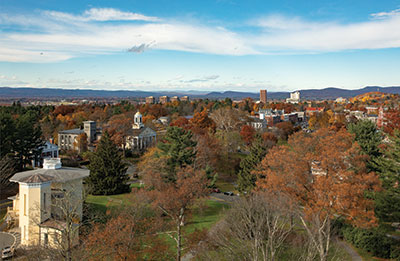A new book by Pulitzer Prize-winning architecture critic Blair Kamin ’79 celebrates Amherst College’s rich architectural legacy and the stories its buildings tell.

“While Amherst is a community in space—an intimate face-to-face college rather than an impersonal university—it is also a community in time,” Kamin observes in the book’s introduction. “Its history now stretches back more than two hundred years, and its campus, seemingly fixed but always changing, exerts a strong gravitational pull.”
Organized as a series of six walks and covering styles that range from Greek Revival to Modernism, Amherst College: The Campus Guide accompanies the reader on a richly engaging tour of the College that spans history and culture as well as space and time. In a “Farther Afield” section, the book also explores three notable off-campus structures: the Five College Library Depository, whose nickname, “The Bunker,” reflects its original function as a Cold War command post; Amherst House at Doshisha University in Kyoto, Japan, built in 1932 to resemble an Amherst fraternity house; and the architecturally distinguished Folger Shakespeare Library, in the shadow of the U.S. Capitol in Washington, D.C.
Throughout Amherst College: The Campus Guide, Kamin skillfully interweaves his expert, in-depth analyses of the College’s architecture and landscape architecture with campus lore. Readers learn, for example, of the townspeople who gathered to construct Amherst’s first building, South College, in 1820, and how the poet Emily Dickinson’s grandfather secured a donation from a dying, childless farmer in nearby Pelham to fund the iconic Johnson Chapel. Specially commissioned hand-drawn maps by Christopher Beck locate buildings and highlight historic and contemporary architectural elements. The campus bears the imprint of many distinguished firms in architecture and landscape architecture, including those of Frederick Law Olmsted; McKim, Mead & White; Benjamin Thompson; Edward Larrabee Barnes; Shepley Bulfinch; and Michael Van Valkenburgh.
In the book’s foreword, Amherst College President Biddy Martin describes her first visit to the campus, when she was moved by the “stunning surroundings” of the main quadrangle. “As the essays in this volume underscore, the evolution of New England campus architecture over the past two hundred years finds palpable expression in Amherst’s buildings,” notes Martin. Observing how the College’s newest buildings create fresh vantage points from which to see historic structures, she writes: “What could be more fitting than changes to a campus that offer unexpected new views and connections across past, present and future?”
Kamin’s other books include Why Architecture Matters: Lessons from Chicago. Lieberman, an architectural historian and photographer, previously collaborated with Kamin on Gates of Harvard Yard. Together they have created a vivid and insightful new examination of such beloved campus landmarks as Johnson Chapel and the War Memorial.
“Over the course of two hundred years, Amherst has built an extraordinary campus, one with a rich legacy and an even richer sense of possibility,” Kamin writes in the introduction. “As the college enters its third century, the transcendent traditions of elemental architecture, intimate scale, a vital landscape, and an enduring sense of place should be foremost in our minds as we endeavor to build a more perfect Amherst.”
Related Reading: An excerpt from a new book by a Pulitzer Prize-winning architecture critic